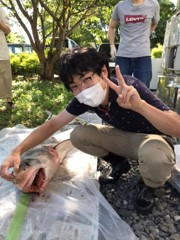18.6.2024
Hello. I am Rintaro Yamada of the Tohoku Museum of History, and I will be writing this column.
Today, I would like to talk about "collecting specimens," which is one of the most basic and unavoidable aspects of zooarchaeology.
In order to identify the bones and shells of animals excavated from archaeological sites, it is essential to have specimens made from the bones or shells of modern animals. No matter how great the analysis, if the original specimen is lacking or inadequate, it may already be enough to call the study bogus. For zooarchaeology, specimens are literally life.
The three principles of specimen collection are "picking up," "buying," and "receiving". Of these, "picking up" requires a strong body and physical strength, mental strength to overcome feelings of shame, virtue and luck from a previous life, and insight into the topography. On the other hand, "receiving" requires immense charm and bargaining power.
And here I will focus on "buying," which involves the least luck, phisical strength, and personality. To continue purchasing complete skeletal specimens would be impossible unless your family is an oil tycoon (the unit price is too high), so most of the time you will buy animals to make bone specimens. A while back, if you wanted to collect fish, you had to go to fish shops and buy all kinds of fish, and you had to become close with the shopkeepers before you could start collecting fish. It was common practice to ask for advice and help in finding fish other than the ones you find at the stores.
Today, however, it has become really convenient. There are sales via the Internet and social networking services. For example, Japan's largest auction site sells not only common edible fish but also rare and deep-sea fish throughout the year. Once you purchase a fish, you can connect directly with the fishmonger who sells them, and they can consult with you about purchasing gillnet and bottom trawl fish in bulk. It is more expensive than real stores, but if you want to be sure of collecting the right kind of fish, you should take advantage of these services.
However, there are, of course, some drawbacks. For example, in my experience, I received a fish different from the one in the photo, a 1.5-meter shark was delivered when I casually purchased it, an eel without bones, a sea cucumber which, of course, has no bones, and a mess
by the time I received the fish after it was sent at room temperature. Unlike real stores, you cannot see their faces, so there will inevitably be problems in these areas. It is best to consider the advantages and disadvantages and make the best choice.
Last but not least, when you purchase fish, you usually have to buy them in bulk, which often results in having a large number of the same fish at hand. There is currently no system for the transfer or exchange of such fish except through personal connections. It would be great if such a system could be made available among members of this society.
Today, I would like to talk about "collecting specimens," which is one of the most basic and unavoidable aspects of zooarchaeology.
In order to identify the bones and shells of animals excavated from archaeological sites, it is essential to have specimens made from the bones or shells of modern animals. No matter how great the analysis, if the original specimen is lacking or inadequate, it may already be enough to call the study bogus. For zooarchaeology, specimens are literally life.
The three principles of specimen collection are "picking up," "buying," and "receiving". Of these, "picking up" requires a strong body and physical strength, mental strength to overcome feelings of shame, virtue and luck from a previous life, and insight into the topography. On the other hand, "receiving" requires immense charm and bargaining power.
And here I will focus on "buying," which involves the least luck, phisical strength, and personality. To continue purchasing complete skeletal specimens would be impossible unless your family is an oil tycoon (the unit price is too high), so most of the time you will buy animals to make bone specimens. A while back, if you wanted to collect fish, you had to go to fish shops and buy all kinds of fish, and you had to become close with the shopkeepers before you could start collecting fish. It was common practice to ask for advice and help in finding fish other than the ones you find at the stores.
Today, however, it has become really convenient. There are sales via the Internet and social networking services. For example, Japan's largest auction site sells not only common edible fish but also rare and deep-sea fish throughout the year. Once you purchase a fish, you can connect directly with the fishmonger who sells them, and they can consult with you about purchasing gillnet and bottom trawl fish in bulk. It is more expensive than real stores, but if you want to be sure of collecting the right kind of fish, you should take advantage of these services.
However, there are, of course, some drawbacks. For example, in my experience, I received a fish different from the one in the photo, a 1.5-meter shark was delivered when I casually purchased it, an eel without bones, a sea cucumber which, of course, has no bones, and a mess
by the time I received the fish after it was sent at room temperature. Unlike real stores, you cannot see their faces, so there will inevitably be problems in these areas. It is best to consider the advantages and disadvantages and make the best choice.
Last but not least, when you purchase fish, you usually have to buy them in bulk, which often results in having a large number of the same fish at hand. There is currently no system for the transfer or exchange of such fish except through personal connections. It would be great if such a system could be made available among members of this society.

The author at a loss in front of the 1.5-meter shark, but takes a picture anyway.
About the author
Rintaro YAMADA
Profile
Mar. 2022 M.A. Graduate School of Arts and Letters, Tohoku University
Mar. 2022 Graduate School of Human Environment Studies, Kyoto University
April 2022 Tohoku Museum of History
Specialty: Zooarchaeology
Subsistence in the Jomon period of the Tohoku region.
Main Achievements
Yamada, Rintaro 2017, "Animal Use in the Late Jomon Period in the Satohama Shell Mound, Miyagi Prefecture," Bulletin of the Tohoku University Museum, 16 pp. 27-67
Yamada, Rintaro 2019, "Fish Use in the Late Jomon Period and its Seasonal Differences: An Example from the Sen-Taiwan Area to the Sanriku Coast," Zooarchaeology, 36 pp.21-34
Yamada, Rintaro 2021, "The Use of Japanese Deer in the Late Jomon Period and its Seasonal Differences: From Sendai Bay to the Sanriku Coast," Quarterly of archaeological studies (Kōkogaku kenkyū), 67-4 pp.18-38
Mar. 2022 Graduate School of Human Environment Studies, Kyoto University
April 2022 Tohoku Museum of History
Specialty: Zooarchaeology
Subsistence in the Jomon period of the Tohoku region.
Main Achievements
Yamada, Rintaro 2017, "Animal Use in the Late Jomon Period in the Satohama Shell Mound, Miyagi Prefecture," Bulletin of the Tohoku University Museum, 16 pp. 27-67
Yamada, Rintaro 2019, "Fish Use in the Late Jomon Period and its Seasonal Differences: An Example from the Sen-Taiwan Area to the Sanriku Coast," Zooarchaeology, 36 pp.21-34
Yamada, Rintaro 2021, "The Use of Japanese Deer in the Late Jomon Period and its Seasonal Differences: From Sendai Bay to the Sanriku Coast," Quarterly of archaeological studies (Kōkogaku kenkyū), 67-4 pp.18-38

